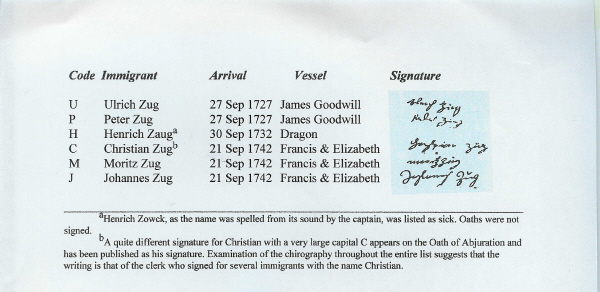|
|
The
18th Century Immigrants
Beginning in 1727, the
Provincial
Council of Pennsylvania required captains of ships importing aliens to
submit
lists of names of those transported. Also, male passengers sixteen
years and
older were required within forty-eight hours of arrival to take an oath
of
allegiance to “His present Majesty King George the Second,
and
his successors,
Kings of Great Britain.” Additional Oaths of Fidelity and
Abjuration renouncing
allegiance to James III, pretender to the throne, were required
beginning in
1729. Oaths were signed by immigrants who could write their
names. A clerk wrote the names for those unable to write, and the
immigrants
made their characteristic marks. The translation by William J Hinke
includes
additional ship lists from 1785 to 1808. The original lists are in the
Pennsylvania Archives at Harrisburg.
A careful evaluation of these lists leads
to the conclusion
that only six immigrants with our surname arrived at Philadelphia in
the 18th century.

Longer
lists have not survived
further scrutiny. “George Zeug,” said to be a
cousin of
Ulrich Zug, was Jerg
Zeng. His signature is in agreement with the captain’s
spelling
of the name
(Zengh). “Henry Zug,” said to be on the same ship,
simply
does not exist; his
name does not appear on the captain’s list or in the
published
versions, except
that of Rupp. Christian “Zug” who arrived in 1738,
signed
his name to both
oaths as Zuegri. Joseph “Zug,” who came in August
1750, was
Joseph Hug (Hook),
and Jacob “Zuch” who came in 1754, was Jacob Auch,
as he
signed twice on 30
September.
Because at least five of the six
immigrants were closely related to each other and were the ancestors of
over
75% of the Zooks in 1920 America, their genealogy and history is of
interest to
an exceptionally large number of people.
Important new facts concerning these immigrants were discovered in
recent years.
- First
was the marriage
of a "Widow Zuck" of Kaiserslautern
in the German Palatinate to a Jacob Guth who planned to move to nearby
Wilensteinerhof, but soon sailed to America on the ship carrying the
three 1742 immigrants.
- Secondly,
1688 and
1720 patrimonial leases were found for
Wilensteinerhof in which an Anabaptist Christian Zoug/Zug participated
as co-lessee. In the first lease, no wife was mentioned, but in the
second lease, a wife Barbara was a participant.
- Thirdly,
the fourth,
fifth, and sixth owners of a Keller
Bible, found by Neil Ann Stuckey Levine, were born with the Zoug name.
Hans Zoug wrote in the Bible that he received it from Christian Zoug,
and then used it to record the births of five children: Anna, b
September 1710; Hans, b 21 May 1712; Barbara, b 16 September 1714;
Magdalena, b 19 June 1716; and Christian, b 21 February 1718. These
first documentations in the Palatinate of a Hans Zoug family with sons
Johannes and Christian are in accord with legend that the name of the
father of the 1742 immigrant Christian was Hans.
- Finally,
confirmation
of the Palatinate as the locale of
Zougs whose records were found in the Kennel Bible and proof of direct
descent of 1742 immigrants Johannes and Christian from 1688 lessee
Christian Zug of Wilensteinerhof was found by Kurt Knebel and wife
Irmgard in an addendum to a second copy of the 1720 lease. Dated 20
April 1742, just five months and one day before arrival of the 1742
immigrants at Philadelphia, the addendum is a memorandum of approval by
Baron von Haake of the sale of one-half of Wilensteinerhof by Christian
and Johannes Zug "which had devolved upon them from their father, for
them and all their co-heirs."
Thus, we now have birth dates for two 1742 immigrants and proof that
they are direct second-generation descendants of Christian Zoug/Zug of
Wilensteinerhof. Legend that they descend from Anabaptist leader Hans
Zaugg of Signau is no longer credible.
Legend that the 1727 immigrants were uncles
of the 1742 immigrants is reasonable, but they would be sons of
Barbara, second wife of Christian Zoug/Zug of Wilensteinerhof, whereas
two 1742 immigrants were sons of Hans, son of a first wife of Christian
Zoug of Wilensteinerhof. Immigrant Peter Zug is documented at
Wilensteinerhof in 1716 on a list of people employed in Amt Trippstadt.
Neither
Ulrich Zug nor Moritz Zug is
documented in
Europe. Their birth dates and parentage are unknown! Futhey and Cope's
History of Chester County states that Moritz was a son of immigrant
Peter Zug. This claim was made both in connection with Moritz's house
and his Bible, details of which were available at that time only from
Moritz's great grand-son M453 Jacob M Zook who lived in the house and
owned the Bible. If so, Moritz remained in Europe in 1727 and was
raised by the 1742 immigrant family. Immigrant Christian's branch of
this family referred to Moritz as Moritz A Zug. The complete 1880
letter of John Hertzler to Michael Zug refers six times to Moritz A
Zug, but neither of these authors used a middle initial in Moritz's
name in their extensive works several years later. We note that
Moritz's name is absent from the Bible record of his "brothers," and
not mentioned by the baron when he approved sale of the patrimonial
lease.
Little
is known about the ancestry of
1732 immigrant
Henrich Zaug, son of Hans Ulrich Zaug, "inhabitant" of Hoffenheim in
the Kraichgau east of the Rhine. He was married 29 June 1717 in the
Lutheran Church to Elizabeth Schwartz, daughter of the late Martin
Schwartz, "citizen." A year earlier, in the Roman Catholic records of
nearby Sinsheim, we find the marriage of his brother Ulrich to Anna
Maria, daughter of Joseph Huber, "citizen." Who was this lowly
"inhabitant" whose sons married into families of Lutheran and Catholic
citizens? One possibility is the Uli Zougg banished in 1761 from Canton
Bern, Switzerland, at age 30.
Back to top of page
|

